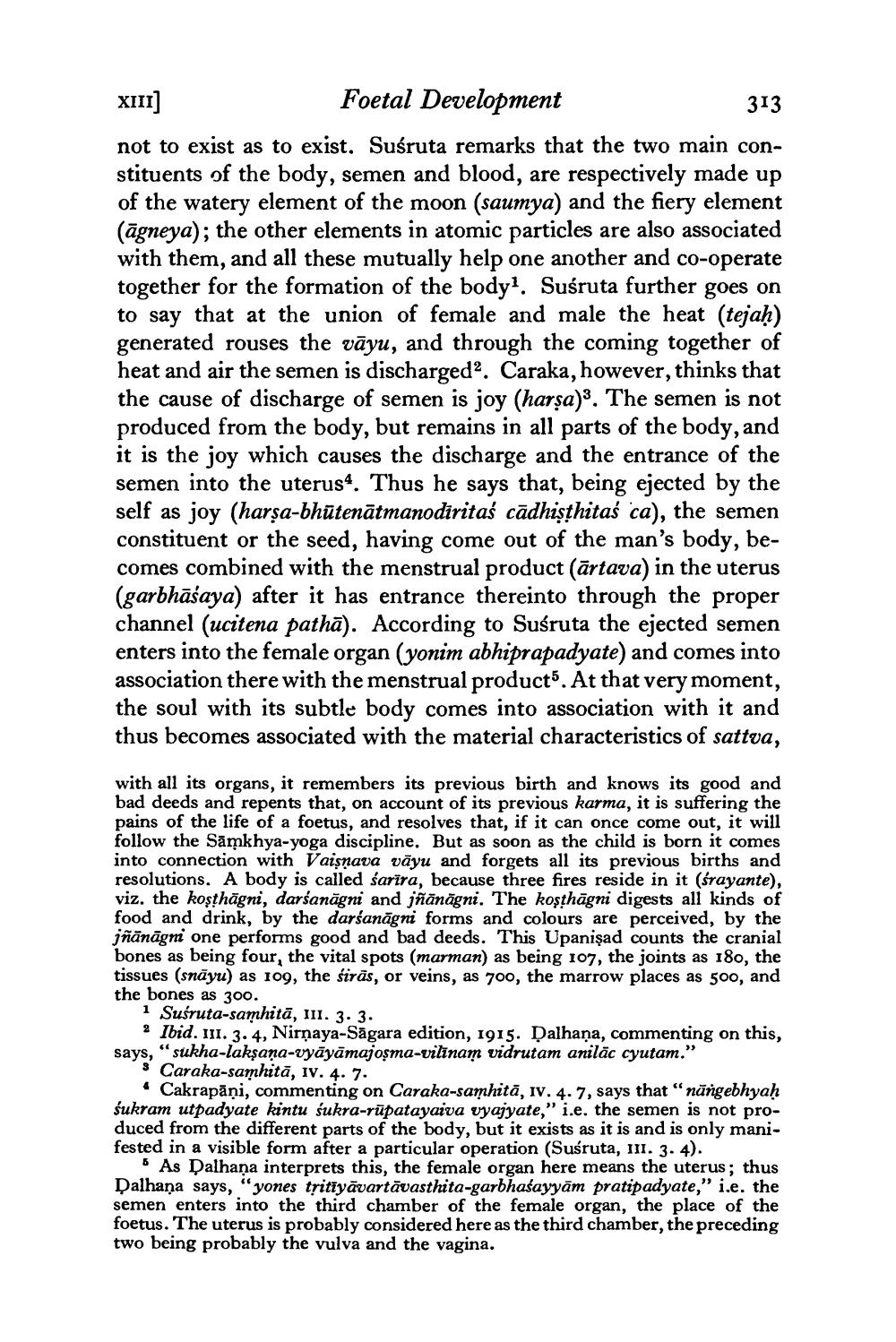________________
XIII]
Foetal Development
313
not to exist as to exist. Suśruta remarks that the two main constituents of the body, semen and blood, are respectively made up of the watery element of the moon (saumya) and the fiery element (agneya); the other elements in atomic particles are also associated with them, and all these mutually help one another and co-operate together for the formation of the body1. Suśruta further goes on to say that at the union of female and male the heat (tejah) generated rouses the vayu, and through the coming together of heat and air the semen is discharged2. Caraka, however, thinks that the cause of discharge of semen is joy (harṣa)3. The semen is not produced from the body, but remains in all parts of the body, and it is the joy which causes the discharge and the entrance of the semen into the uterus. Thus he says that, being ejected by the self as joy (harṣa-bhūtenātmanodiritas cadhiṣṭhitaś ca), the semen constituent or the seed, having come out of the man's body, becomes combined with the menstrual product (ārtava) in the uterus (garbhāśaya) after it has entrance thereinto through the proper channel (ucitena patha). According to Suśruta the ejected semen enters into the female organ (yonim abhiprapadyate) and comes into association there with the menstrual products. At that very moment, the soul with its subtle body comes into association with it and thus becomes associated with the material characteristics of sattva,
with all its organs, it remembers its previous birth and knows its good and bad deeds and repents that, on account of its previous karma, it is suffering the pains of the life of a foetus, and resolves that, if it can once come out, it will follow the Samkhya-yoga discipline. But as soon as the child is born it comes into connection with Vaisnava vayu and forgets all its previous births and resolutions. A body is called sarira, because three fires reside in it (śrayante), viz. the koşṭhāgni, darśanāgni and jñānāgni. The koşṭhāgni digests all kinds of food and drink, by the darśanagni forms and colours are perceived, by the jñānāgni one performs good and bad deeds. This Upanisad counts the cranial bones as being four, the vital spots (marman) as being 107, the joints as 180, the tissues (snāyu) as 109, the siras, or veins, as 700, the marrow places as 500, and the bones as 300.
1 Suśruta-samhita, III. 3. 3.
2 Ibid. III. 3. 4, Nirnaya-Sagara edition, 1915. Dalhana, commenting on this, "sukha-lakṣaṇa-vyāyāmajoṣma-vilinam vidrutam anilāc cyutam."
says,
3 Caraka-samhita, IV. 4. 7.
Cakrapāņi, commenting on Caraka-samhitā, IV. 4. 7, says that "nängebhyaḥ śukram utpadyate kintu sukra-rupatayaiva vyajyate," i.e. the semen is not produced from the different parts of the body, but it exists as it is and is only manifested in a visible form after a particular operation (Suśruta, III. 3. 4).
As Dalhana interprets this, the female organ here means the uterus; thus Dalhana says, "yones tritiyavartavasthita-garbhaśayyam pratipadyate," i.e. the semen enters into the third chamber of the female organ, the place of the foetus. The uterus is probably considered here as the third chamber, the preceding two being probably the vulva and the vagina.




